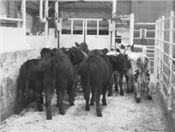|
Prove Your Cattle Are Better Than Average With Data From Feedout

Since 1981 University of Missouri Extension, along with other partners, have provided the Missouri Steer Feedout as a low
risk opportunity to see how your cattle compare to your neighbor’s.
MT. VERNON, MO.
Most cattle producers have left the sale barn before feeling that their cattle did not bring their true value. One of the best ways to combat that feeling is to prove your cattle are above average according to Eldon Cole, field specialist in livestock with University of Missouri Extension.
“If you think you have above-average cattle it would behoove you to feed a few of them after weaning up to slaughter weight and have their carcasses evaluated. Then, and only then, will you find if your cattle deserve a premium or perhaps a discount,” said Cole.
There are several opportunities for both small and large cowherd owners to get post-weaning performance data.
“This data will show if your cattle are above or below average,” said Cole.
FEEDOUT DETAILS
Since 1981 University of Missouri Extension, along with other partners, have provided the Missouri Steer Feedout as a low-risk opportunity to see how your cattle compare to your neighbor’s.
Here are a few details on the next planned Feedout.
• Eligible steers must be born in 2019.
• Five head minimum - no maximum.
• Entry fee is $20 per steer due by Oct. 10.
• All post-weaning expenses will be withheld from the final paycheck after all steers are slaughtered.
• Steers should be weaned, castrated and dehorned 45 days before delivery to the pickup point on Nov. 5.
• Pickup point are the Paris Veterinary Clinic, Paris and Joplin Regional Stockyards, Carthage.
• Desired weights on Nov. 5 are at least 500 lbs. and not over 900 lbs.
• Follow the pre-weaning protocol for vaccinations, etc. to the letter. You may contact your Extension specialist or search on-line for details.
• A value will be placed on each steer at weigh-in by a Missouri Market News reporter. This is used to calculate profitability post-weaning.
• Complete feedlot data, health treatments, etc. will be handled by Iowa's Tri-County Steer Carcass Futurity Cooperating feedlot in southwest Iowa.
• Carcass data will include weight, fat thickness, ribeye area, marbling score, kidney, pelvic, heart fat, quality and yield grade. The cattle will be sold on a Grid basis which determines the true value of the carcass.
WHY ENTER FEEDOUT
Persons enter steers in the Feedout for a variety of reasons, according to Cole.
Over the years, he has kept track of the reasons shared and participants have given these responses: I receive carcass data; Helps me make bull decisions; I've learned about grading both alive and carcass; You can't tell how they’ll perform by just looking at them live; We’ve learned which cows and bulls are not profitable.
“If you have steers that year-after-year rank above average then when you market their herd mates, those Feedout results can be shared with your marketing agency. They, in turn, can use that information when your cattle come through the ring,” said Cole.
MORE INFORMATION
University of Missouri Extension also has some publications online related to the feedout.
The brochure is now available on line for the 2019-2020 Feedout at http://extension.missouri.edu/lawrence/documents/FOBrochure2019-20.pdf.
A detailed review of the 2018-2019 Feedout from start to finish may be found at
http://extension.missouri.edu/lawrence/documents/Feedout18-19(1).pdf.
A sheet on “How do your feeder cattle compare” can be seen at http://extension.missouri.edu/lawrence/documents/Comparison18-19.pdf. ∆
|
|